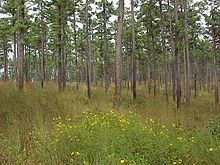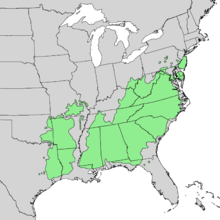Pinus echinata
| Shortleaf pine | |
|---|---|

| |
| Shortleaf Pine forest | |
| Scientific classification | |
| Kingdom: | Plantae |
| Clade: | Tracheophytes |
| Clade: | Gymnospermae |
| Division: | Pinophyta |
| Class: | Pinopsida |
| Order: | Pinales |
| Family: | Pinaceae |
| Genus: | Pinus |
| Subgenus: | P. subg. Pinus |
| Section: | P. sect. Trifoliae |
| Subsection: | P. subsect. Australes |
| Species: | P. echinata
|
| Binomial name | |
| Pinus echinata | |

| |
| Natural range | |
Pinus echinata, the shortleaf pine,[2] is a species of pine native to the eastern United States from southernmost New York State, south to northern Florida, west to eastern Oklahoma, and southwest to eastern Texas. The tree is variable in form, sometimes straight, sometimes crooked, with an irregular crown. This tree reaches heights of 20–30 metres (65–100 ft) with a trunk diameter of 0.5–0.9 metres (1 ft 8 in – 2 ft 11 in).
The leaves are needle-like, in fascicles (bundles) of two and three mixed together, and from 7–11 cm (2+3⁄4–4+1⁄4 in) long. The cones are 4–7 cm (1+1⁄2–2+3⁄4 in) long, with thin scales with a transverse keel and a short prickle. They open at maturity but are persistent.[3] Shortleaf pine seedlings develop a persistent J-shaped crook near the ground surface.[4] Axillary and other buds form near the crook and initiate growth if the upper stem is killed by fire or is severed.
This pine is a source of wood pulp, plywood veneer, and lumber for a variety of uses. The shortleaf pine is one of the southern US "southern yellow pines; it is also occasionally called southern yellow pine or the shortstraw pine. Shortleaf pine has the largest range of the southern US yellow pines.
This pine occupies a variety of habitats from rocky uplands to wet flood plains. It frequently hybridizes naturally with loblolly pine and pitch pine where their ranges intersect.
References
- ^ Farjon, A. (2013). "Pinus echinata". The IUCN Red List of Threatened Species. 2013. IUCN: e.T42359A2974993. doi:10.2305/IUCN.UK.2013-1.RLTS.T42359A2974993.en. Retrieved 13 December 2017.
- ^ USDA, NRCS (n.d.). "Pinus echinata". The PLANTS Database (plants.usda.gov). Greensboro, North Carolina: National Plant Data Team. Retrieved 4 October 2015.
- ^ Kral, Robert (1993). "Pinus echinata". In Flora of North America Editorial Committee (ed.). Flora of North America North of Mexico (FNA). Vol. 2. New York and Oxford: Oxford University Press – via eFloras.org, Missouri Botanical Garden, St. Louis, MO & Harvard University Herbaria, Cambridge, MA.
- ^ Lawson, Edwin R. (1990). "Pinus echinata". In Burns, Russell M.; Honkala, Barbara H. (eds.). Conifers. Silvics of North America. Vol. 1. Washington, D.C.: United States Forest Service (USFS), United States Department of Agriculture (USDA) – via Southern Research Station.
External links
 Media related to Pinus echinata at Wikimedia Commons
Media related to Pinus echinata at Wikimedia Commons- Gymnosperm Database: Pinus echinata
- NCRS: USDA Plants Profile: Pinus echinata
- IUCN Red List least concern species
- Pinus
- Trees of the Eastern United States
- Flora of the Appalachian Mountains
- Trees of the Southeastern United States
- Trees of the South-Central United States
- Trees of the Southern United States
- Trees of the North-Central United States
- Trees of the Northeastern United States
- Least concern plants

